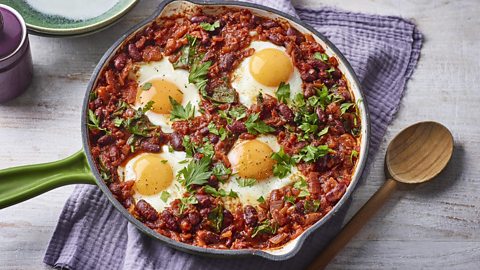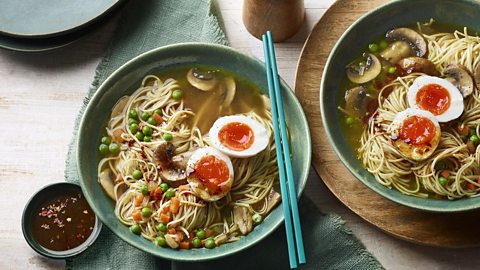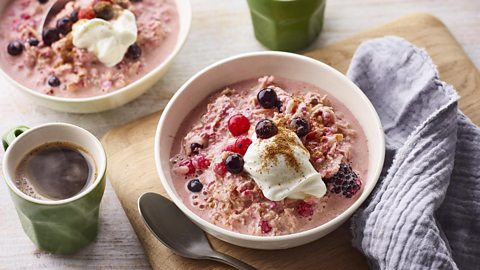Dr Rupy’s surprisingly simple tactic for upping your veg intake
To protect our health, experts say we should be eating 10 portions of fruit and veg a day and at least 30 different plants a week. Here’s how I do it without spending lots of money or time in the kitchen.

The British Dietetic Association states that just eight percent of children and 27 percent of adults manage to consume five portions of fruit and vegetables a day.
While it’s important that more of us reach that goal regularly, I think the target itself needs re-evaluating, too. The science is clear on the health benefits of eating plants, so the more portions we manage each day, the better. For me, 10 is the magic number – and studies have proven this to be true.
Sound daunting? Getting more fruit and veg into your diet is easier than you might think – and there’s no need to fork out loads of money or spend lots of time in the kitchen to do it.
Why it’s important to eat more plants
Research by Imperial College has found that eating up to 800g (that’s 10 portions) of fruit and veg could offer substantial protection against disease. Scientists analysed 95 studies and found this to be the optimum intake, associating it with a 33 percent reduced risk of stroke, 28 percent reduced risk of cardiovascular disease and 13 percent reduced risk of cancer when compared to not eating any fruit and veg at all.
What’s more, the chances of premature death were 31 percent lower in those who got their 10-a-day.
Variety is important as well. The communities of microbes that live in our guts need lots of different plant-based nutrients to stay healthy and diverse – and that’s important to remember as the state of our gut is linked to our overall health. ‘Plant points’ are a great way to track how many different plant-based foods you have in your diet; 30 is a good number to aim for each week. You get a point for every different plant you eat, including nuts, seeds, legumes and grains as well as fruit and veg.
Cannellini bean and pea stew
This wallet-friendly stew will give you a head start on reaching your plant point goal for the week

I’m living proof of how eating 10 portions of fruit and veg a day and 30 plant points a week can benefit you. Back when I was a junior doctor, I was diagnosed with atrial fibrillation, which is a condition that gives you an irregular heart rhythm. Two or three times a week I’d have episodes where my heartbeat was going up to around 200 beats per minute.
In addition to following fellow doctors’ advice and seeing some of the best cardiologists in the world, my mother dished out her own tips, pulling me up on my diet of beige convenience foods. With a heart operation looming, I decided to transform the way I ate.
After a year and a half of filling my diet with fruit, veg, nuts, seeds, lentils, beans and legumes, I’d reversed the condition.
The easy way to add more fruit and veg to your meals
When I started to improve my diet, I lived by a 'just one more' rule. It really helped me and is a happily easy method to follow – I still use it now. When I’m preparing a meal, I ask myself, ‘how can I add just one more portion of fruit, vegetables, nuts or seeds to this meal?’ It’s often simply a case of throwing one extra ingredient into your dish.
So if, for instance, you’re making lasagne and are serving it with a side of salad leaves, ask yourself 'how can I add one more?’ Perhaps you could roast some butternut squash, steam some broccoli or add another ingredient to the salad, like radishes. You might already have some veg in the fridge that’s looking sad and needs using up – get it involved!
This way of thinking soon becomes second nature. It’s a really useful strategy that helps you to broaden your plant consumption and think differently about fruit and veg.
Ways to use fruit and veg in your cooking
Use alliums for base flavours
A lot of people forget that allium vegetables like garlic, onions and leeks count towards your 10-a-day. Not only are they nutritious, but they also give dishes a great base-line flavour that grows richer as you get further into the cooking process. They're good value for money too – especially onions.
Spicy kidney beans and baked eggs
This hearty dish is packed with veg and makes a great brunch, lunch or dinner

Don’t dismiss tinned veg
Vegetables don’t have to be fresh to count towards your 10-a-day, so make the most of convenient and affordable tins. Tinned tomatoes are particularly versatile; they’re often staple ingredients in the likes of ragu and curry, for instance.
Make friends with your freezer
Frozen fruit and veg are often very affordable and help to save on waste too, as they lasts so much longer. I put frozen peas in literally everything. I'll blend them up and turn them into a pesto, toss them into curries and add them to stir-fries. If all else fails, I will have plain peas on the side.
I also use a lot of frozen broad beans, green beans and fruit. Because they’re flash-frozen just after being picked, they retain a lot of their original nutrient value too, which is something that can decrease over time in fresh produce.
Mushroom, pea and carrot ramen with quick chilli oil
Frozen peas help to up the veg count in this warming ramen

Have a backup plan
It’s great to have a meal plan when you go to the supermarket to help keep your spend down, but it always works in your favour to be flexible. That way, if the vegetable you were going to buy is expensive you can swap it with a cheaper option. For example, if you were planning on picking up a celeriac but it’s gone up in price, think about whether the recipe would work with a swede, turnip or sweet potato instead. The chances are something else will do the job just as well – it’s just a case of knowing which vegetables are interchangeable.
Experiment with different preparation
There are so many ways to cook each kind of vegetable; you can get completely different results in terms of flavour and texture by preparing the same ingredient using different methods. For example, as well as sliced and sautéed or stuffed and roasted, mushrooms can be finely chopped and used as a base ingredient in a sauce. While they’ll add an umami flavour there won’t be an overwhelming mushroom taste or texture – which is great for those who aren’t keen on them.
Remember you’re not dieting
When you’re in the process of adding more plants to your diet, stay focussed on why you’re doing it. It’s about improving your health, not being restrictive with your food. Remember the point is to add to your meals, not to take anything away. So don’t be afraid to cook dishes that feel like a treat.
Apple, pear and berry bircher
Swap your bowl of cereal for this colourful breakfast dish, packed with plant points

You could stew some frozen berries and finish with a crumble-like topping of oats, nuts and coconut oil for a sweet dessert that's full of goodness. Maybe even top it with dark chocolate shavings and a drizzle of honey or maple syrup.
In that dish you've got fibre as well as polyphenols (plant-based micro nutrients) which are associated with good heart health. Even the dark chocolate includes flavonoids which come with their own benefits. A pudding like this contributes towards your 10-a-day, but when you sit down to eat it, you’re just enjoying a comforting fruit crumble.
Now make:
Originally published January 2023